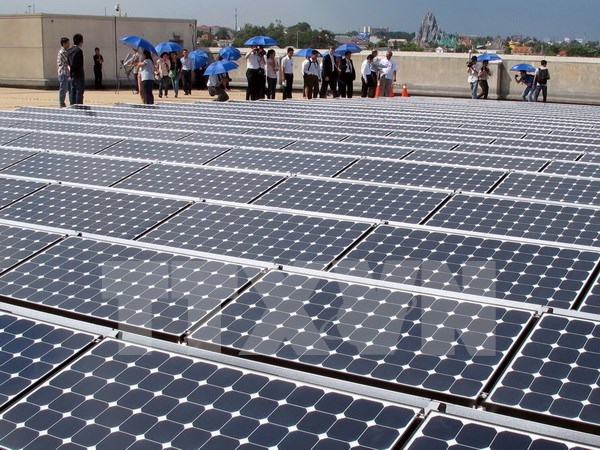HCM City targets power savings of 2.5 percent by 2020
HCM City has set a target to save 2.5 percent of energy consumption between now and 2020, according to a report by city authorities.
 Solar panel on the top of an Intel factory in Vietnam (Photo: VNA)
Solar panel on the top of an Intel factory in Vietnam (Photo: VNA)HCM City (VNA) - HCM City has set a target to save 2.5 percent of energy consumption between now and 2020, according to a report by city authorities.
To achieve the goal, the city will use high-performance equipment and energy-efficient technologies, while gradually replacing low-performing equipment and removing outdated technology.
The city, which aims to ensure energy savings at manufacturing facilities, plans to reduce energy consumption by 10 percent in several energy-intensive industries.
In addition, the plan calls for improving fuel efficiency of the transport system and limiting environmental pollutants.
At least 10 percent of businesses would be using an energy-management system by 2020, while 100 percent of construction would be completed in compliance with national technical standards for economical use of energy, according to the report.
The plan also calls for high-performance lighting equipment installed at all public light locations.
This year, the city is expected to consume between 21,400 and 21,600 million kWh, a rise of 7-8 percent over 2015, according to EVN HCM City.
Solar-power subsidies
Last year, the city’s Department of Science and Technology’s Energy Saving Centre launched a pilot programme to financially support households, businesses and companies that use solar energy to generate power.
The programme funding for 2015 and this year totals 10 billion VN D (449,000 USD ), according to the centre.
The households and companies receive help to install solar-energy systems and connect them with public power lines.
The city administration gives the participants a subsidy of 2,000 VN D or 0.09 USD for every kilowatt they produce.
Huynh Kim Tuoc, Director of the HCM City Energy Saving Centre, said that 10 households and six enterprises had received support from the programme, worth 125 million VN D last year.
Since the beginning of the year, more than 30 enterprises have participated in the programme, with a total capacity of 500kWp.
The programme is expected to create a foundation for agencies to create further incentives for investment in green energy, such as solar, wind and biomass power.
Financial support
Nguyen Khac Thanh, Deputy Director of the Department of Science and Technology, said it was vital to raise people’s awareness about energy efficiency.
Thanh said that industry, high-rises, transportation, schools and hospitals should use energy-efficient technologies.
Since the middle of last year, 16 State-owned companies and organisations have committed to becoming more energy-efficient, saving 481 million kWh of electricity and 5.6 million litres of oil in the 2015-17 period, a savings of 807 billion VN D (38.4 million USD ).
The Saigon Co.op Mart, HCM City Export Processing and Industrial Zone Authority, Saigontourist and several others have agreed to join the city’s green strategy, which will help cut 285,000 tonnes of emissions.
The Department of Science and Technology will assist them with technical solutions, equipment and technologies.
With increased demand for power and the impact of climate change, the city wants companies and organisations to use energy efficiently, with the State sector being the pioneer.
Tuoc, of the Energy Conservation Centre, said that HCM City would face a critical energy shortage in the near future if energy-saving solutions were not adopted.
Transport and industrial sectors and households are among the largest consumers of energy.
While most businesses should use energy-efficient technologies to improve competitiveness, they lack capital and need support from the government, including loans with low interest rates.
HCM City has financially supported more than 1,000 enterprises with more than 6,000 solutions to save energy, including advanced technology in production and management.
For households, the best way would be the use of high-performance equipment and energy-efficient technologies, and gradual replacement of low-performance equipment, according to Tuoc.-VNA













